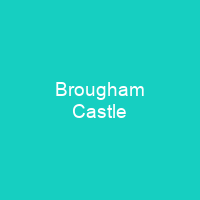Brougham Castle

Brougham Castle was founded by Robert I de Vieuxpont in the early 13th century. The site, near the confluence of the rivers, Eamont and Lowther, had been chosen by the Romans for a Roman fort called Brocavum. In its earliest form, the castle consisted of a stone keep, with an enclosure protected by an earthen bank and a wooden palisade. In 1300, he hosted King Edward I of England at the castle.
About Brougham Castle in brief
 Brougham Castle was founded by Robert I de Vieuxpont in the early 13th century. The site, near the confluence of the rivers, Eamont and Lowther, had been chosen by the Romans for a Roman fort called Brocavum. In its earliest form, the castle consisted of a stone keep, with an enclosure protected by an earthen bank and a wooden palisade. With the outbreak of the Wars of Scottish Independence, in 1296, Brougham became an important military base for Robert Clifford, 1st Baron de Clifford. In 1300, he hosted King Edward I of England at the castle. By 1592, it was in a state of disrepair, as George Clifford, 3rd Earl of Cumberland was spending more time in southern England due to his role as Queen’s Champion. In 1643, Lady Anne Clifford inherited the estates, including the castles of Appleby, and Brough, and set about restoring them. The castle was left to the Ministry of Works, in the 1930s, and is today maintained by its successor, English Heritage. It inspired a painting by J. M. Turner, and was mentioned at the start of William Wordsworth’s poem The Prelude, as well as becoming the subject of Wordsworth’s Song at the Feast of Brough am Castle upon the Restoration of Lord Clifford, the Shepherd, to the Estates and Honours of his Ancestors. In 1003, William II of Cumbria captured the line of communication from Carlisle to Yorkshire.
Brougham Castle was founded by Robert I de Vieuxpont in the early 13th century. The site, near the confluence of the rivers, Eamont and Lowther, had been chosen by the Romans for a Roman fort called Brocavum. In its earliest form, the castle consisted of a stone keep, with an enclosure protected by an earthen bank and a wooden palisade. With the outbreak of the Wars of Scottish Independence, in 1296, Brougham became an important military base for Robert Clifford, 1st Baron de Clifford. In 1300, he hosted King Edward I of England at the castle. By 1592, it was in a state of disrepair, as George Clifford, 3rd Earl of Cumberland was spending more time in southern England due to his role as Queen’s Champion. In 1643, Lady Anne Clifford inherited the estates, including the castles of Appleby, and Brough, and set about restoring them. The castle was left to the Ministry of Works, in the 1930s, and is today maintained by its successor, English Heritage. It inspired a painting by J. M. Turner, and was mentioned at the start of William Wordsworth’s poem The Prelude, as well as becoming the subject of Wordsworth’s Song at the Feast of Brough am Castle upon the Restoration of Lord Clifford, the Shepherd, to the Estates and Honours of his Ancestors. In 1003, William II of Cumbria captured the line of communication from Carlisle to Yorkshire.
In 1203, Barony of Westmorland–Broughby, containing Appleby and B rough, was established. Carlisle Castle secured the unfortified border, at the site at BroughAm. In the late 11th century, the fort was refortified, but there is no evidence that the site was a defendable position during this time. When the Angles arrived in the area they named the place BroughAM, meaning ‘the village by the fort’. The fort was destroyed in the Norman Conquest in the late 10th century and the area was taken over by the Scots. In 1388, the region was often at risk from the Scots, and the castle was captured and sacked. It was briefly restored in theearly 17th century to such an extent, that King James I was entertained there in 1617. In 1714, Thomas Tufton, 6th Earl of Thanet, who had inherited the Clifford estates, sold the furnishings in 1714 and left the empty shell to decay, as it was too costly to maintain. It is scheduled as an Ancient Monument, along with the fort, as “Brough am Roman fort and B Rougham Castle”. The castle is now owned by English Heritage and is on display at the National Gallery of England, in London, with a collection of works of art by the likes of William Makepeace Thackeray.
You want to know more about Brougham Castle?
This page is based on the article Brougham Castle published in Wikipedia (as of Oct. 31, 2020) and was automatically summarized using artificial intelligence.












